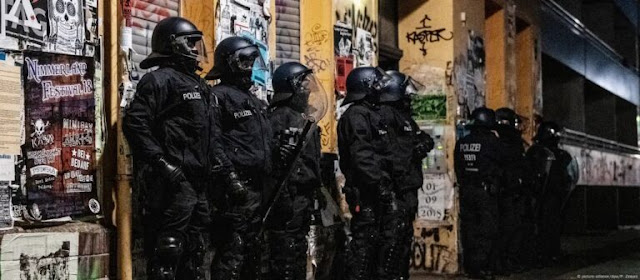On the morning of Thursday, August 28, 2025, Berlin police launched an extensive operation involving over 700 officers to storm a building at 94 Rigaer Strasse, a property in the Friedrichshain district long associated with the city’s far-left movement. Armed with court-issued warrants, the police used battering rams and saws to breach barricaded doors, supported by technical experts to facilitate entry. The raid, which targeted 12 apartments and involved 15 individuals, aimed to identify the building’s current residents amid ongoing legal disputes over its occupancy. Additional sites, including the Berlin Regional Court and the offices of the property’s owner, were also secured as part of the operation. While the landlord claims the occupants are illegal squatters, the residents’ resistance to eviction has made Rigaer Strasse a flashpoint for tensions between Berlin’s authorities, property owners, and its activist community. This article provides a comprehensive examination of the raid, its context, the legal and social issues at play, and its broader implications for Berlin’s urban and political landscape.
The Raid: A High-Stakes Operation
The operation at 94 Rigaer Strasse was one of the largest police actions in Berlin in recent years, underscoring the significance of the site as a symbol of resistance within the city’s far-left movement. The deployment of over 700 officers, a scale typically reserved for major security threats, highlighted the authorities’ determination to assert control over the contested property. The use of battering rams and saws to break through barricaded doors reflected the physical and symbolic barriers erected by the occupants, who have long resisted police interventions.
The raid’s primary objective, according to Berlin police, was to identify the current residents of the building. Officers searched 12 apartments, engaging with 15 individuals, though no arrests were reported, and residents were allowed to remain in the property pending further legal proceedings. The operation was supported by technical experts, likely brought in to navigate the complex fortifications installed by the occupants, which have made previous attempts to access the building challenging.
In addition to the main target, police secured two related sites: the Berlin Regional Court, which has been involved in the legal disputes over Rigaer Strasse, and the offices of the property’s owner. These actions suggest a coordinated effort to address not only the physical occupation but also the broader legal and administrative issues surrounding the property. The police’s acknowledgment of potential protests or unrest indicates their awareness of the site’s significance to Berlin’s activist community and the likelihood of a backlash.
Despite these concerns, the immediate aftermath of the raid was calm, with no reported clashes in Friedrichshain. However, the operation has reignited debates about squatting, gentrification, and the role of police in managing urban conflicts, setting the stage for potential future confrontations.
Rigaer Strasse: A Symbol of Resistance
Located in the Friedrichshain district, 94 Rigaer Strasse has been a focal point of Berlin’s far-left movement for decades. The partially occupied building, known as “Rigaer94,” is a hub for anarchist and autonomist groups who view it as a space for alternative living, community organizing, and resistance against capitalism and gentrification. The property has been at the center of legal disputes between its residents, the landlord, and city authorities, with multiple eviction attempts met with fierce opposition.
The history of Rigaer94 is deeply tied to Berlin’s squatting culture, which flourished in the 1980s and 1990s, particularly after the fall of the Berlin Wall. During this period, abandoned buildings in East Berlin were occupied by activists seeking affordable housing and spaces for political and cultural activities. While many squats were legalized or cleared over time, Rigaer94 has remained a stronghold of resistance, symbolizing the city’s radical heritage.
The landlord, a private entity, claims that the occupants are illegal squatters without valid tenancy agreements. Multiple eviction notices have been issued over the years, but the residents, supported by a network of activists, have consistently blocked these efforts through physical barricades, protests, and legal challenges. The building’s fortified state, with reinforced doors and windows, reflects the occupants’ determination to maintain control, making police interventions like the August 28 raid logistically complex.
The Legal and Social Context
The raid on Rigaer Strasse must be understood within the broader context of Berlin’s urban and political dynamics, where issues of housing, gentrification, and activism intersect:
Housing Crisis and Gentrification:
Berlin has faced a severe housing crisis in recent years, with rising rents and a shortage of affordable apartments. Gentrification, particularly in districts like Friedrichshain, has displaced low-income residents, fueling tensions between developers, landlords, and activists. Rigaer94, as a symbol of resistance to market-driven displacement, has become a rallying point for those opposing the commodification of housing.
The landlord’s claim that the occupants are illegal squatters reflects a broader push by property owners to reclaim valuable real estate in gentrifying neighborhoods. However, activists argue that such actions prioritize profit over community, exacerbating inequality in a city once known for its affordability.
Far-Left Activism:
The far-left movement in Berlin, encompassing anarchists, autonomists, and other radical groups, has a long history of challenging state authority and capitalist systems. Rigaer94 is a key space for these groups, hosting events, workshops, and political organizing. The building’s occupants view their resistance as a defense of alternative lifestyles and a critique of neoliberal urban policies.
The police raid, seen by activists as an attack on their autonomy, is likely to galvanize support within the far-left community. Previous interventions at Rigaer94 have sparked protests, vandalism, and clashes with police, raising concerns about potential unrest following the August 28 operation.
Legal Disputes:
The legal battles over Rigaer94 involve complex questions of property rights, tenancy agreements, and public order. The landlord’s assertion that the occupants lack valid contracts is contested by residents, who claim historical rights to the space based on their long-term occupancy. The involvement of the Berlin Regional Court in the raid suggests that legal proceedings will play a central role in determining the property’s future.
The court-issued warrants used in the raid indicate that authorities have secured judicial backing for their actions, but the residents’ history of legal challenges suggests that the dispute is far from resolved.
Police Strategy and Public Response
The scale of the police operation, involving over 700 officers, reflects the authorities’ recognition of Rigaer94’s significance as a flashpoint. The use of battering rams, saws, and technical experts underscores the physical and logistical challenges posed by the building’s fortifications. By targeting not only the property but also related sites like the court and the landlord’s offices, the police aimed to address the issue comprehensively, signaling a zero-tolerance approach to unauthorized occupations.
The police’s decision to allow residents to remain in the property for now suggests a strategic choice to avoid immediate escalation. Past attempts to clear Rigaer94 have led to violent protests, and authorities may be seeking to de-escalate tensions while pursuing legal avenues to resolve the dispute. However, the acknowledgment of potential “spontaneous protests or unrest” indicates that the police are prepared for a backlash, particularly given the far-left movement’s history of mobilizing quickly in response to such actions.
Public reactions, as seen on platforms like X, are divided. Some Berliners support the police, viewing the raid as a necessary step to restore order and uphold property rights. Others, particularly within activist circles, condemn the operation as an overreach, accusing authorities of criminalizing dissent and prioritizing corporate interests. The calm in Friedrichshain immediately following the raid suggests that activists may be strategizing their response, potentially organizing protests or solidarity actions in the coming days.
Broader Implications for Berlin and Beyond
The raid on Rigaer Strasse has significant implications for Berlin’s social, political, and urban landscape, as well as broader debates about squatting and housing rights:
Urban Policy and Gentrification:
The operation highlights the tension between Berlin’s progressive identity and its transformation into a global city with rising property values. Efforts to clear squats like Rigaer94 reflect a broader push to “clean up” gentrifying neighborhoods, but they risk alienating communities that value the city’s alternative culture.
The housing crisis, with average rents in Berlin rising by over 40% in the past decade, underscores the stakes of this conflict. Policies to address affordability, such as rent caps or social housing initiatives, could mitigate tensions, but the raid suggests a preference for enforcement over dialogue.
Activism and Resistance:
Rigaer94’s status as a far-left stronghold makes it a symbol of resistance against neoliberalism and state authority. The raid could galvanize activists, leading to renewed protests or solidarity campaigns. Conversely, it may deter future occupations if authorities succeed in asserting control over the property.
The far-left movement’s ability to mobilize supporters across Europe could internationalize the issue, drawing attention to Berlin’s housing struggles and influencing similar debates in cities like Amsterdam or Barcelona.
Police-Community Relations:
The scale of the operation has raised questions about police priorities and resource allocation. Critics argue that deploying 700 officers to target a single building diverts resources from other pressing issues, such as crime or public safety. The raid’s success in avoiding immediate violence may bolster police credibility, but long-term relations with Friedrichshain’s activist community remain strained.
Legal Precedent:
The outcome of the legal disputes over Rigaer94 could set a precedent for how squatting cases are handled in Germany. A ruling in favor of the landlord could embolden property owners to pursue similar evictions, while a victory for the residents could strengthen protections for long-term occupants.
Challenges and Opportunities
The raid presents several challenges and opportunities for Berlin’s authorities, residents, and activists:
Challenges:
Managing Unrest: The potential for protests or violence requires careful management to prevent escalation. Previous clashes at Rigaer94 have led to injuries and property damage, and authorities must balance enforcement with de-escalation.
Addressing Housing Issues: The raid does not address the root causes of squatting, such as housing shortages and rising rents. Without comprehensive policies, similar conflicts are likely to persist.
Public Perception: The operation risks alienating Berliners who view Rigaer94 as a cultural landmark, potentially fueling distrust in authorities.
Opportunities:
Dialogue and Mediation: The raid could prompt dialogue between authorities, landlords, and residents to find a resolution that respects both property rights and community needs. Mediation efforts could set a model for addressing similar disputes.
Policy Reform: The incident highlights the need for policies to address Berlin’s housing crisis, such as expanding social housing or regulating rents. Such reforms could reduce the appeal of squatting while preserving the city’s progressive identity.
Community Engagement: Engaging with Friedrichshain’s residents, including activists, could help authorities rebuild trust and address underlying grievances, fostering a more collaborative urban environment.
Conclusion
The massive police raid on 94 Rigaer Strasse on August 28, 2025, marks a significant moment in Berlin’s ongoing struggle over housing, gentrification, and activism. By deploying over 700 officers to target a building synonymous with the city’s far-left movement, authorities have signaled their intent to assert control over a contested space. The operation, while calm in its immediate aftermath, has reignited debates about property rights, urban development, and the role of police in managing social conflicts.
Rigaer94’s status as a symbol of resistance underscores the deeper issues at play, from Berlin’s housing crisis to the tensions between capitalism and alternative lifestyles. The raid’s outcome, both legally and socially, will shape the city’s approach to similar disputes and influence broader conversations about urban policy and activism. As Berlin navigates these challenges, the need for dialogue, reform, and a balanced approach to enforcement will be critical to fostering a city that remains inclusive, vibrant, and true to its progressive roots.






